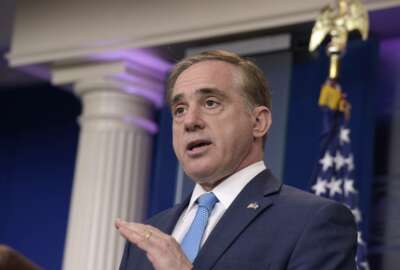
Under 10-year Cerner contract, VA to follow DoD’s same EHR implementation path
The Veterans Affairs Department has a few more details about its 10-year contract with Cerner Corporation with a new, interoperable electronic health record with...
Subscribe to Federal Drive’s daily audio interviews on iTunes or PodcastOne.
The Veterans Affairs Department is wrapping up final negotiations with Cerner Corporation for a new electronic health record, and it needs congressional help to reshuffle VA resources and get the project off the ground.
To foot the bill for the first year of the new contract, the department first wants Congress to finish and include funds in the agency’s 2018 appropriations bill. But if Congress doesn’t pass all appropriations bills and develops an omnibus or another continuing resolution for the rest of fiscal year, VA wants Congress to transfer $782 million from its other appropriations accounts to initiate the EHR modernization project in this year. About $92 million would come from VA’s Office of Information and Technology (OI&T) and the remaining $692 million come from unobligated balances in medical care accounts.
And because of certain funding restrictions under the continuing resolution, VA will ask for a smaller transfer — $373.8 million in fiscal 2018.
“This contingency enables VA to avoid cost increases and allows us to move forward with IT infrastructure modifications and expanding our program management office to provide the necessary oversight and manage implementation,” VA Secretary David Shulkin told the House Appropriations Military Construction, Veterans Affairs and Related Agencies Subcommittee on Wednesday.
The department will sign a 10-year contract with Cerner to deploy a new health record across 1,600 VA facilities and community providers. The new EHR will replace 130 different versions of the department’s current Veterans Information Systems and Technology Architecture (VistA), Shulkin said.
VA is still negotiating the terms of its contract, but once both parties finish, the department estimates it will take about 18 months to implement the new EHR at the first VA site. It will take another seven to eight years before the system is fully deployed.
The negotiations come after Shulkin in June announced his plans to adopt MHS Genesis, the same EHR system that DoD is deploying. The Pentagon is implementing the health record to sites in the Pacific Northwest, and VA said it intends to follow DoD’s same deployment path.
Three DoD sites are online now, including Fairchild Air Force Base in Spokane, Washington.
“By us deploying into the same geographic area, we’ll be able to leverage the resources that are already in that area,” said John Windom, program executive for VA electronic health record modernization. “If we deployed east, clearly they would have to stand up a full team that would have to, again, support our deployment on the opposite part of the country. We believe and have seen, as part of the negotiation process, substantial efficiencies in that area and in that strategy.”
Getting in step with DoD’s implementation plan is key, VA officials said, and they’re relying on Congress to help the department find the funding to get the project off the ground quickly.
“We have to do this quickly,” Shulkin said. “We have achieved substantial discounts by aligning our EHR deployment and implementation with the Department of Defense.”
But some members of the House appropriations subcommittee were skeptical. Many of them were in the same room in 2011, when former VA Secretary Eric Shinseki and former Defense Secretary Bob Gates promised the committee they would create a common, interoperable EHR.
Latest Veterans Affairs News
“Mr. Secretary, I look forward to being surprised,” said Rep. Debbie Wasserman-Schulz (D-Fla.), the subcommittee’s ranking member, who questioned Shulkin on VA’s aggressive implementation timeline.
If VA doesn’t receive the funding transfer in fiscal 2018, total project costs will increase at least 5 percent if the department misses its current opportunity to align with DoD EHR deployment, Shulkin said.
But those total costs, at least publicly, are still unknown.
Subcommittee members said they would discuss more specific details of the Cerner contract and cost estimates with VA officials in a closed session after Wednesday’s hearing.
Shulkin has repeatedly said VA would save billions of dollars over 10 years by moving to the new health record, and implementing the interoperable system in the same sites at the same time as DoD will turn over more cost savings.
VA officials said they were confident in the collaboration they’ve created so far with DoD on the project. Windom, now the program manager for the VA project, led the Pentagon’s own EHR modernization efforts.
Both departments have also set up an inter-agency governance board, which includes the VA deputy secretary and the Defense undersecretary for acquisition, technology and logistics. Cerner and Leidos are also non-voting members of the board, Windom said.
“We are using the lessons from DoD,” Shulkin said. “If they weren’t talking to us and sharing this, I’d be much more concerned. But they are so fully committed to our success that I believe that saves a lot of time and a lot of money for taxpayers.”
At VA, the deputy secretary, undersecretary for health and chief information officer, along with IT experts from the department’s OI&T and clinicians at the Veterans Health Administration, all sit on VA’s EHR governance board.
As it suggested in the past, the department is also planning to work with other vendors to put VA’s systems on the path to interoperability with affiliated academic and community partners. Shulkin said VA recently published a request for information to collect industry’s ideas about its digital health exchange.
The department’s current IT employees will continue to stay on to operate VistA for the next 10 years as Cerner deploys the new EHR, Shulkin said. The vendor will handle basic upkeep and ongoing modernization efforts once it finishes deploying the system.
“Our current employees, we need every one of them. … We want them to stay; we need them to stay over this implementation period,” Shulkin said. “Any staff, once we shut down the VistA system, will be utilized as part of our current IT infrastructure needs. We do not believe this will be a job loss.”
Copyright © 2025 Federal News Network. All rights reserved. This website is not intended for users located within the European Economic Area.
Nicole Ogrysko is a reporter for Federal News Network focusing on the federal workforce and federal pay and benefits.
Follow @nogryskoWFED
Related Stories

In abandoning VistA, VA faces culture change that’s ‘orders of magnitude bigger’ than expected

Shulkin announces new direction for VA electronic health record




